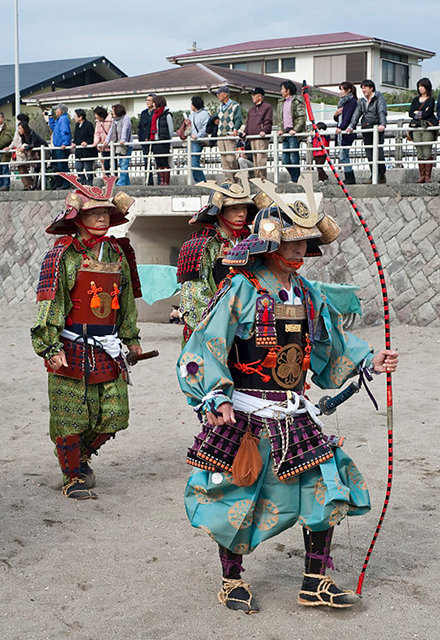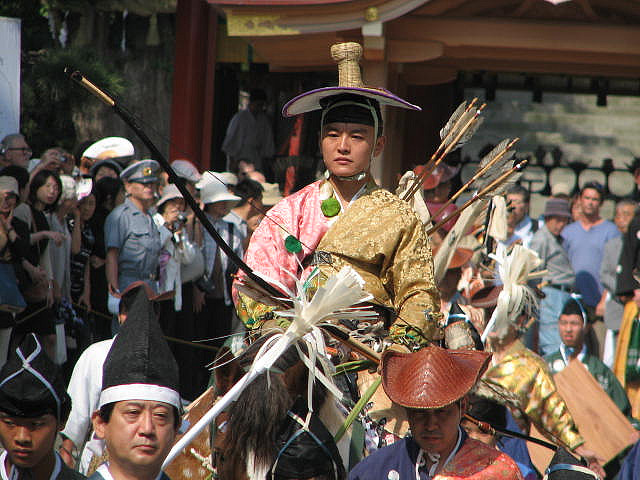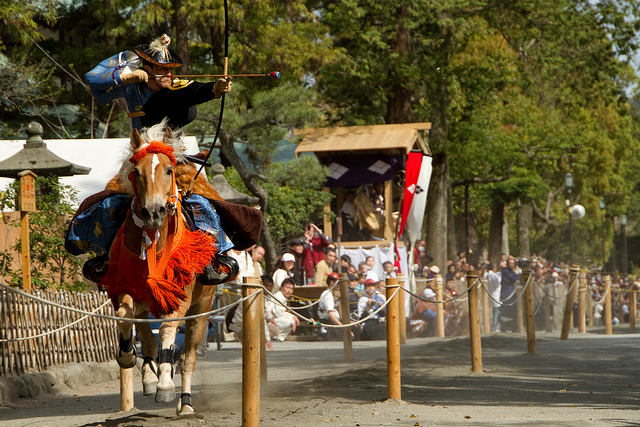 This picture from the race schedule.
This picture from the race schedule.
Yabusame is a martial art which helped a samurai learn concentration, discipline, and refinement. Zen taught breathing techniques to stabilize the mind and body, giving clarity and focus. To be able to calmly draw one's bow, aim, and shoot in the heat of battle, and then repeat, was the mark of a true samurai who had mastered his training and his fear.
February 5 after a major cold spell I bundled up, took my faulty camera and headed with our friend Yosh and some of his work mates down towards Hakkone. It was held in the countryside with a fabulous view of Fujisama.
Hurrah an outing where my hiking boots are de rigeur. In beautiful sunshine we walked with a crowd of people through the plum orchards to where the track had been set up.
And though I knew that plum blossoms started to bloom in February I never expected to see huge orchards in full bloom. A bit early I hear, but perhaps in this low lying protected area it happens early with gusto.
When Yosh gave me the arm band to wear I began to wonder if I would have to guard the bows or something, but it got us into the room where the riders were getting ready.......
and then to lunch with all the people organizing the event. I realized that Yosh is a main driver of this event......If anyone out there has a connection to someone who might love to bring this event to Canada let me know, Yosh would love to develop that possibility. It is an interesting piece of live history, connecting aboriginal skills, cowboy events, ancient history and beliefs. It would be an exciting presentation to add to any horse show.
Eventually about 1000 people gathered and everything was ready exactly on schedule.
Fujisama over saw the entire event.
Japanese appreciation of nature and especially trees was part of the activity. Many people ate their lunch or served soups and tea under the blossoms.
Yabusame has religious roots and begins with a ceremony I was largely able to understand because of Yosh.
The priest asked the gods from Mt.Fujisama to bless the event, riders, the fertility of the earth and ask for an abundant harvest.
The Shinto priest is standing on the race track so you can see the width of the track in this picture.
The spectators are close. Most people are sitting on tarps laid out for them along the edge of the course. I was sitting on a chair just about where this man is kneeling...very close!
Yabusame itself is very simple. An archer on horseback starts at one end of a roped-off track around 255 metres long, and gallops down it at high speed. Without stopping or slowing down, he fires three arrows in succession, each at one of three wooden targets placed about 70 metres apart on one side of the track. He then has to slow down quickly so he can stop before the end of the track – no mean feat given how fast the archers ride. The whole run is over in around 20 seconds, and the score is based simply on how many targets have been hit.
Don’t let the simplicity of the sport (or ritual as most practitioners would prefer it to be called) lead you into thinking that it’s easy. The archers need to use both hands for shooting, so they have to rely on their knees alone to control the horses. As they let loose the arrows they shout ‘in-yo-in-yo’ – meaning darkness and light (the two opposite cosmic forces, sometimes called yin and yang). Hitting even one target is hard, and hitting all three is a major achievement – the mark of a supreme expert.
(A procession at the Tsurugaoka Shrine in Kamakura, prior to the yabusame tournament. Internet pic)
Race & association officials, judges, dressed in ancient garb, horse handlers, trainees and riders dressed in their magical silks (some proudly able to wear their family emblem on their shoulder) took part in the opening ritual.
Below, officials checking the track.
Yabusame-two traditions
Ogasawara School
The founder, Ogasawara Nagakiyo, was instructed by the shogun Minamoto Yoritomo (1147–1199) to start a school for archery.
Takeda, is the school of Yabusame, which Yosh supports. This
archery school was begun earlier by Minamoto Yoshiari in the 9th century at the command of Emperor Uda. This school became known as the Takeda school of archery. The Takeda style has been featured in classic samurai films such as Akira Kurosawa's "Seven Samurai" (1954) and "Kagemusha" (1980). The famed actor of many samurai films, Toshiro Mifune, was a noted student of the Takeda school.
Japanese bows date back to prehistoric times — the Jōmon Period. The long, unique asymmetrical bow style with the grip below the center emerged under the Yayoiculture (300 BC – 300 AD). Bows became the symbol of authority and power. The legendary first emperor of Japan, Emperor Jimmu, is always depicted carrying a bow. The Bow is called Yumi. Yabusame has been a symbol for dignitaries to highlight their power.
Now the hat the riders wear looks like Roy Rodgers cowboy hat. It’s called a kishagasa and it is made of woven bamboo and then lacquered. It’s the very latest in yabusame headgear, although the term “latest” might be a tad misleading since this hat is an innovation introduced around 1726 by the eighth Tokugawa shogun, Yoshimune.
A rider being helped to get ready.
The procession down to the race start at the end of the track. The riders bowed to the officials at the second target where I was sitting....feeling somewhat Queenly.
There was a period of around four hundred years, beginning in the fourteenth century, when yabusame was no longer practiced, but it was resurrected in 1728 on the orders of the then shogun, Yoshimune Tokugawa. At the time his son Ieshige was sick with smallpox, 
(These yabusame judges at Zushi are dressed in armour, and each is carrying a pair of samurai swords. Internet pic)so he decided to use
yabusame as a petition to the gods to seek a cure. As the rules of yabusame had been written down in the twelve century, it was possible to resurrect it and perform it again exactly as in ancient times. Happily, the gods obliged, and Ieshige made a complete recovery, eventually going on to succeed his father as shogun.
As with kyudo (ordinary Japanese archery without horses), yabusame is a solemn activity, and is about a lot more than just equestrian prowess and skill with a bow. It was originally intended to increase both the mental strength and religious devotion of the samurai who took part, as well as honing their battle skills. To this day, a yabusame archer is expected to follow the principles of bushido (the way of the warrior), and so must respect God and his ancestors, and act with good manners at all times. The Ogasawara School even teaches its pupils the correct way of bowing and of opening and closing doors.
Archers compete not for money, but for honour – the best performing archer is given a white cloth to signify divine favour, but receives no monetary payment. Even being selected as a yabusame archer is seen as a great honour – yabusame teachers are not paid, so their principle gain in passing on their skills is to increase their reputation by producing skilled pupils.
Yabusame can be seen either as an offering to, or entertainment for, the gods (although we mortals are usually allowed to watch as well). Both the arrows that hit their targets, and the targets themselves, are kept and treasured as good luck charms. The Ogasawara also use yabusame as a form of weather forecasting. The count of the number of arrows that hit the targets is used to predict how good the harvest will be in the years to come.
Yabusame archers are still equipped exactly as they were in the twelfth century. They wear medieval hunting outfits, including a distinctive woven-reed hat, a cloak, an arm guard, and a deerskin fur covers their legs. They carry a quiver of arrows on their back (from which they must draw new arrows as they gallop past the targets), a bow, a lacquered riding crop, and a pair of samurai swords – one long and one short.
If you couldn’t see the other spectators, there’d be nothing to indicate that you weren’t in twelfth-century Japan – everything else is exactly as it was then. Well, except that samurai who performed poorly were sometimes required to commit seppuku (ritual suicide by disembowelling) – that doesn’t go on any more. The best thing is that you can get really close up to the action – only a rope fence separates you from the galloping horses.
(You can see here the narrow track at Tsurugaoka Shrine on which the the horses gallop, and just how close the spectators are to the action.internet pic.)
Thanks Yosh! Next at the Calgary stampede! Or a First Nations Pow Wow! Friends, you can pass this on to people who might be interested.






















No comments:
Post a Comment